Effect of Two- and Three-Dimensionally Designed Guide Vanes with Different Camber Length on Static Pressure Recovery of a Wall-Mounted Axial Fan
Abstract
:1. Introduction
2. Axial Fan and Guide Vanes
2.1. Wall-Mounted Axial Fan Unit
2.2. Guide Vanes
2.3. Inlet Motor Effect
3. Numerical Setup
3.1. Computational Domain and Grid System
3.2. Governing Equation and Turbulence Model
3.3. Boundary Condition
3.4. Solver Information
4. Experimental Validation
5. Results and Discussion
5.1. Two- and Three-Dimensional Designs
5.2. Further Design
6. Conclusions
- At design and some low flow rate points, the 2D design contained the most favorable performance when the meridional length (linear) was 30% based on total length, and was the worst for 70%. Here, ‘linear’ means the vane angle of zero (0) degrees, parallel to the axis with a plate shape.
- The 3D design method applied in this study did not outperform the 2D design. In terms of mass production, it is appropriate to consider the 2D design.
- If the meridional length of a guide vane is insufficient (short), separation and recirculation can be present near the vane surface, which inhibits the static pressure recovery.
- The following solutions can be suggested to achieve better performance with a guide vane: vaneless duct exhibiting length of 0.25 from the vane outlet; and guide vanes with extended meridional length.
- In the 2D design concept, averaging the flow angle for the entire span at the design flow rate can ensure a better pressure rise over a more comprehensive flow rate range than weighting the flow angle for a specific span.
- The influence of turbulence models between the SST standard and reattachment modification did not have a significant difference in prediction near the design flow rate point.
Author Contributions
Funding
Institutional Review Board Statement
Informed Consent Statement
Data Availability Statement
Conflicts of Interest
References
- Wang, H.; Tian, J.; Ouyang, H.; Wu, Y.; Du, Z. Aerodynamic performance improvement of up-flow outdoor unit of air conditioner by redesigning the bell-mouth profile. Int. J. Refrig. 2014, 46, 173–184. [Google Scholar] [CrossRef]
- Shiomi, N.; Kinoue, Y.; Setoguchi, T.; Kaneko, K. Vortex Features in a Half-ducted Axial Fan with Large Bellmouth (Effect of Tip Clearance). Int. J. Fluid Mach. Syst. 2011, 4, 307–316. [Google Scholar] [CrossRef]
- Eck, B. Fans; Pergamon Press Inc.: New York, NY, USA, 1973. [Google Scholar]
- Bleier, F.P. Fan Handbook; McGraw-Hill: New York, NY, USA, 1998. [Google Scholar]
- Stinnes, W.H.; Von Backström, T.W. Effect of cross-flow on the performance of air-cooled heat exchanger fans. Appl. Therm. Eng. 2002, 22, 1403–1415. [Google Scholar] [CrossRef]
- Ye, X.; Fan, F.; Zhang, R.; Li, C. Prediction of Performance of a Variable-Pitch Axial Fan with Forward-Skewed Blades. Energies 2019, 12, 2353. [Google Scholar] [CrossRef] [Green Version]
- Saeidi, A.; Taheri, P. Numerical Design of a Guide Vane for an Axial Fan. Appl. Model. Simul. 2020, 4, 258–271. [Google Scholar]
- Zhang, L.; Zhang, L.; Zhang, Q.; Jiang, K.; Tie, Y.; Wang, S. Effects of the Second-Stage of Rotor with Single Abnormal Blade Angle on Rotating Stall of a Two-Stage Variable Pitch Axial Fan. Energies 2018, 11, 3293. [Google Scholar] [CrossRef] [Green Version]
- Heinemann, T.; Becker, S. Axial Fan Performance under the Influence of a Uniform Ambient Flow Field. Int. J. Rotating Mach. 2018, 2018, 6718750. [Google Scholar] [CrossRef] [Green Version]
- Clemen, C. Aero-mechanical optimisation of a structural fan outlet guide vane. Struct Multidisc Optim 2011, 44, 125–136. [Google Scholar] [CrossRef]
- Choi, Y.S.; Kim, Y.I.; Kim, S.; Lee, S.G.; Yang, H.M.; Lee, K.Y. A Study on Improvement of Aerodynamic Performance for 100HP Axial Fan Blade and Guide Vane Using Response Surface Method. In Proceedings of the ASME-JSME-KSME 2019 8th Joint Fluids Engineering Conference, San Francisco, CA, USA, 28 July–1 August 2019; Volume 3A: Fluid Applications and Systems, V03AT03A023. ASME: New York, NY, USA, 2019. [Google Scholar] [CrossRef]
- Kim, Y.I.; Suh, W.J.; Choi, Y.U.; Jeong, C.Y.; Lee, K.Y.; Choi, Y.S. Numerical Study on Performance Characteristics of a Wall-mounted Axial Fan with Variation of the Setting Angle. In Proceedings of the KSFM Winter Conference, Yeosu, Korea, 25–27 November 2020. [Google Scholar]
- Lee, S.G.; Lee, K.Y.; Yang, S.H.; Choi, Y.S. A Study on Performance Characteristics of an Axial Fan with a Geometrical Parameters of Inlet Hub Cap. KSFM J. Fluid Mach. 2019, 22, 5–12. [Google Scholar] [CrossRef]
- Menter, F.R.; Galpin, P.F.; Esch, T.; Kuntz, M.; Berner, C. CFD simulations of aerodynamic flows with a pressure-based method. In Proceedings of the 24th International congress of the aeronautical sciences, Yokohama, Japan, 29 August–3 September 2004. [Google Scholar]
- Liu, M. Computational study of convective-diffusive mixing in a microchannel mixer. Chem. Eng. Sci. 2011, 66, 2211–2223. [Google Scholar] [CrossRef]
- Liu, Z.; Xiong, Y.; Chen, Y. Simulation and optimum design of small fan for animal house by CFD. J. Phys. Conf. Ser. 2021, 1820, 012052. [Google Scholar] [CrossRef]
- Menter, F. Two-equation eddy-viscosity turbulence models for engineering applications. AIAA J. 1994, 32, 1598–1605. [Google Scholar] [CrossRef] [Green Version]
- ANSYS Uesr Manual; ANSYS Inc.: Canonsburg, PA, USA, 2016.
- Brown, G.J.; Fletcher, D.F.; Leggoe, J.W.; Whyte, D.S. Investigation of turbulence model selection on the predicted flow behaviour in an industrial crystalliser—RANS and URANS approaches. Chem. Eng. Res. Des. 2018, 140, 205–220. [Google Scholar] [CrossRef]
- Liu, B.; An, G.; Yu, X. Assessment of curvature correction and reattachment modification into the shear stress transport model within the subsonic axial compressor simulations. Proc. IMechE Part A J. Power Energy 2015, 229, 910–927. [Google Scholar] [CrossRef]
- Lee, Y.G.; Yuk, J.H.; Kang, M.H. Flow analysis of fluid machinery using CFX pressure-based coupled and various turbulence model. KSFM J. Fluid Mach. 2004, 7, 82–90. [Google Scholar] [CrossRef]
- Ariff, M.; Salim, S.M.; Cheah, S.C. Wall y+ approach for dealing with turbulent flow over a surface mounted cube: Part 1-low Reynolds number. In Proceedings of the 7th International Conference on CFD in the Minerals and Process Industries, Melbourne, Australia, 9–11 December 2009. [Google Scholar]
- Lee, S.N.; Tak, N.I.; Noh, J.M. Heat transfer prediction in pipe flow by the wall function of SST turbulence model. In Proceedings of the KSCFE Conference, Seogwipo, Korea, 16 May 2013; pp. 355–358. [Google Scholar]
- Jeong, C.Y.; Choi, Y.U.; Lee, K.Y.; Kook, J.K. Basic Design and Development Progress of Wall Mounted Axial Flow Fan for Smoke Ventilation. In Proceedings of the KSFM Winter Conference, Yeosu, Korea, 25–27 November 2020. [Google Scholar]
- Choi, Y.S.; Kim, D.S.; Yoon, J.Y. Effects of Flow Settling Means on the Performance of Fan Tester. KSFM J. Fluid Mach. 2005, 8, 29–34. [Google Scholar]
- ANSI/AMCA 210-07: Laboratory Methods of Testing Fans for Certified Aerodynamic Performance Rating; The Air Movement and Control Association International, Inc.; The American Society of Heating, Refrigerating; Air Conditioning Engineers: Arlington Heights, IL, USA, 2008.
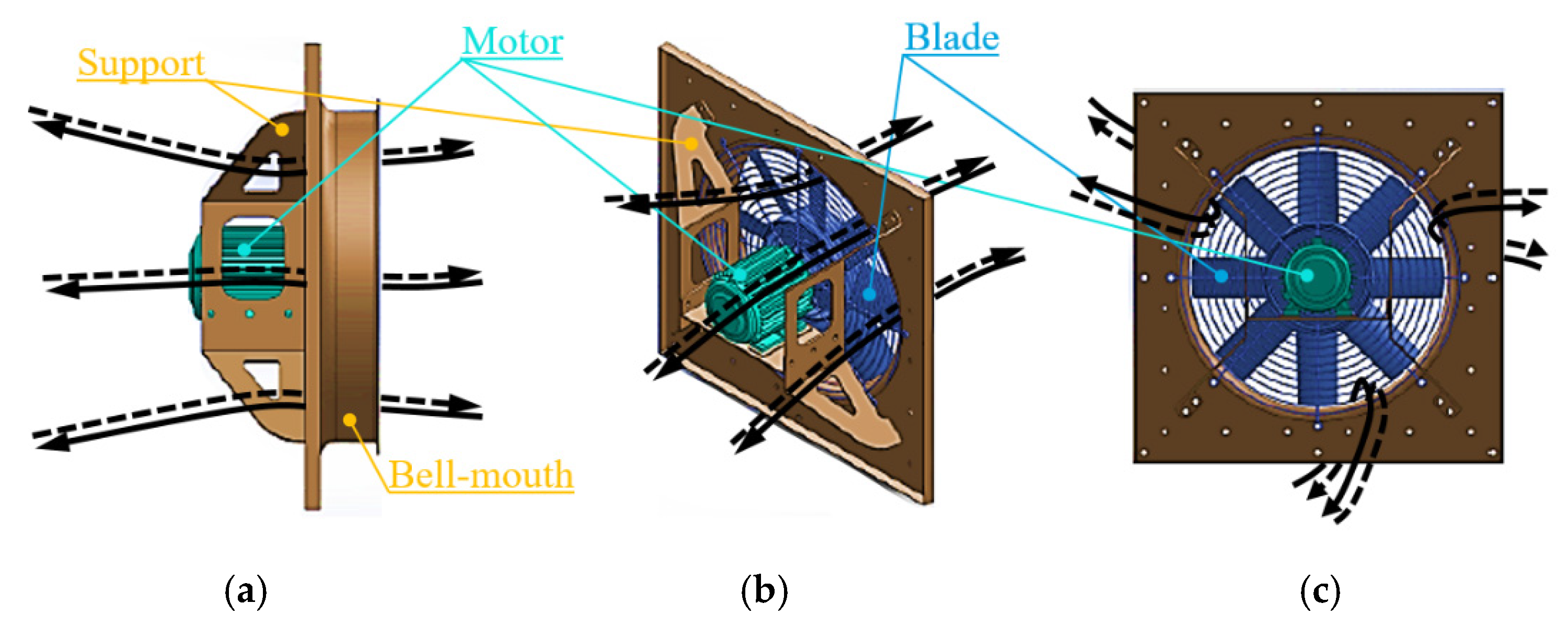
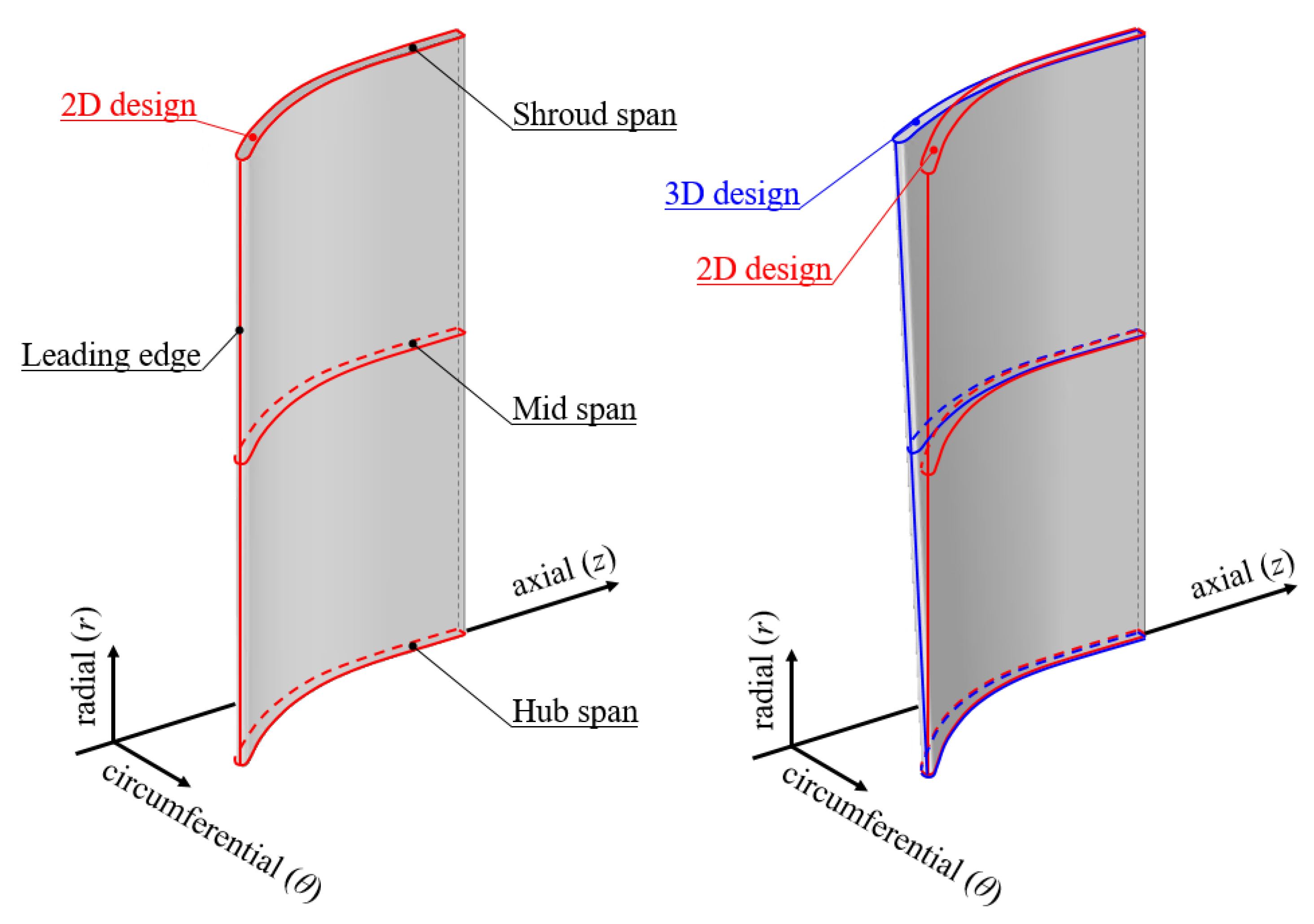
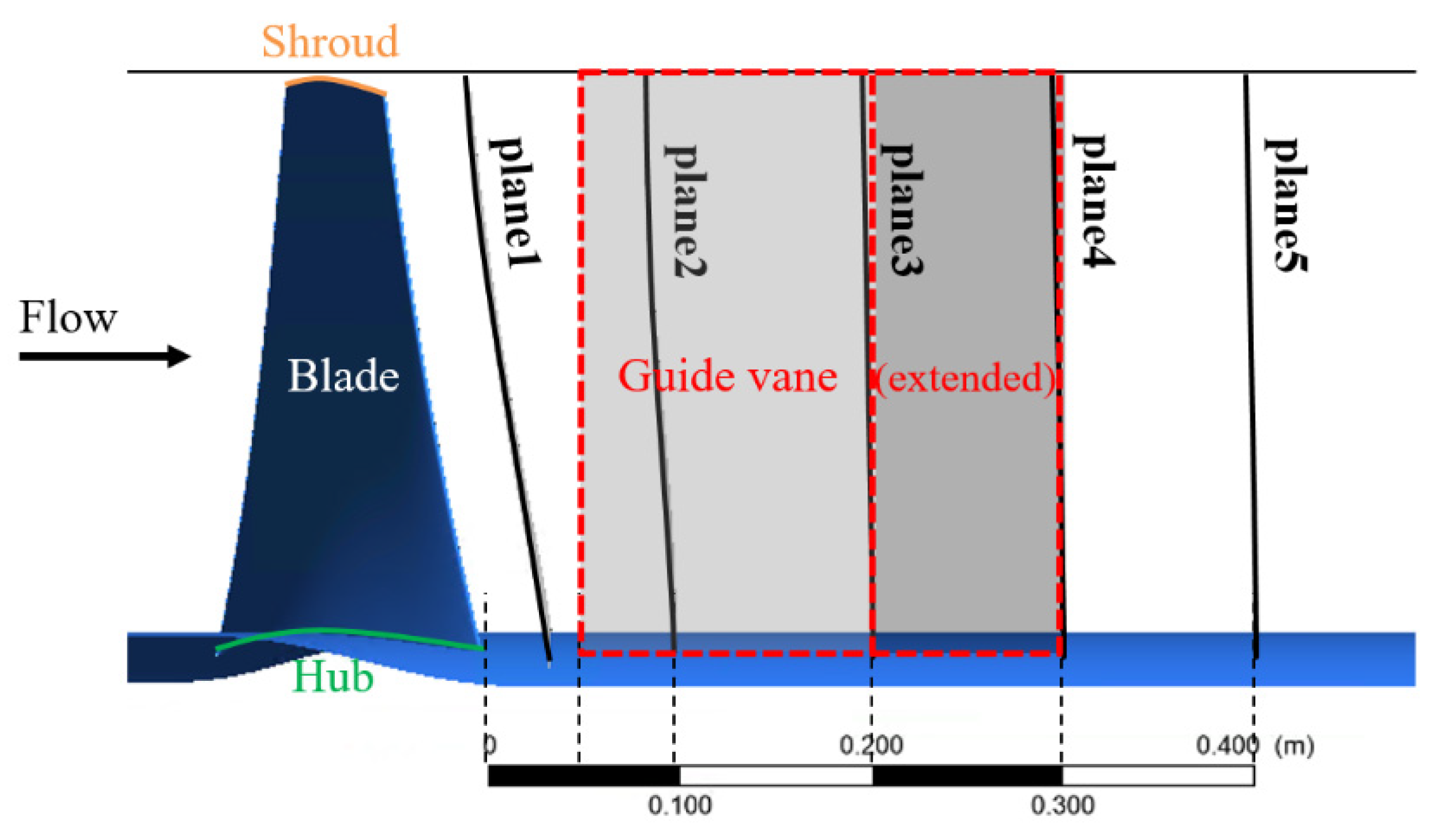
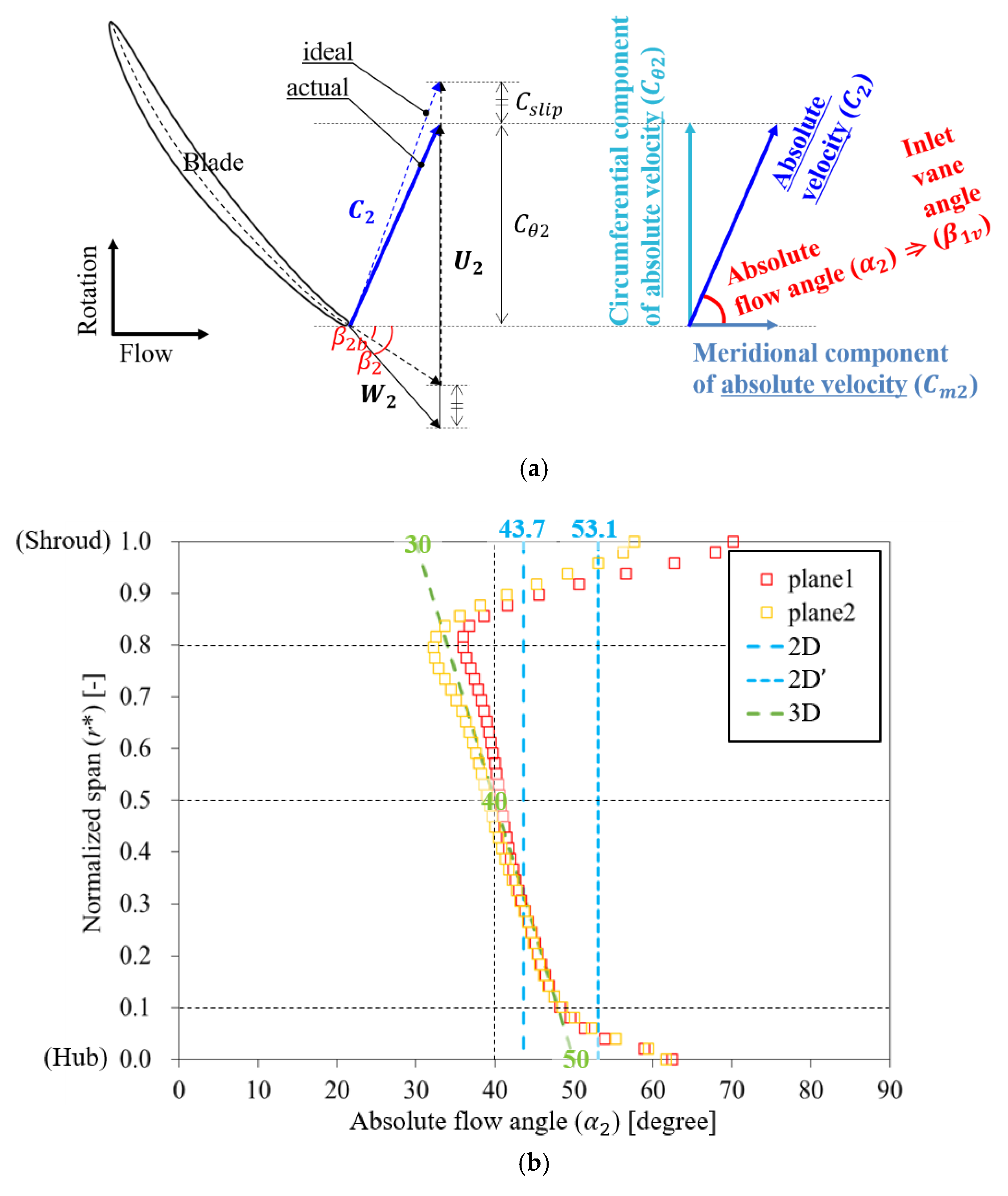
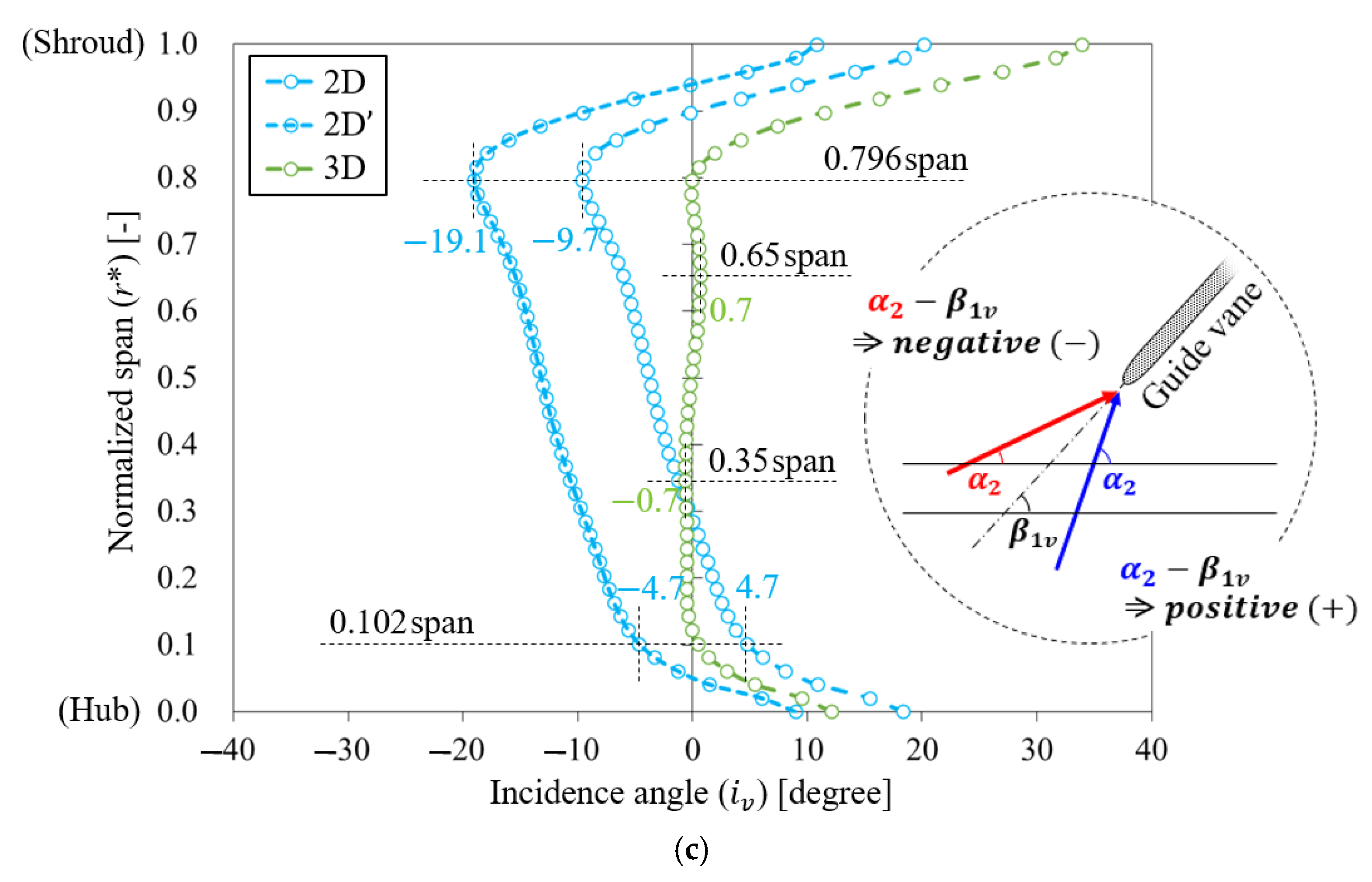
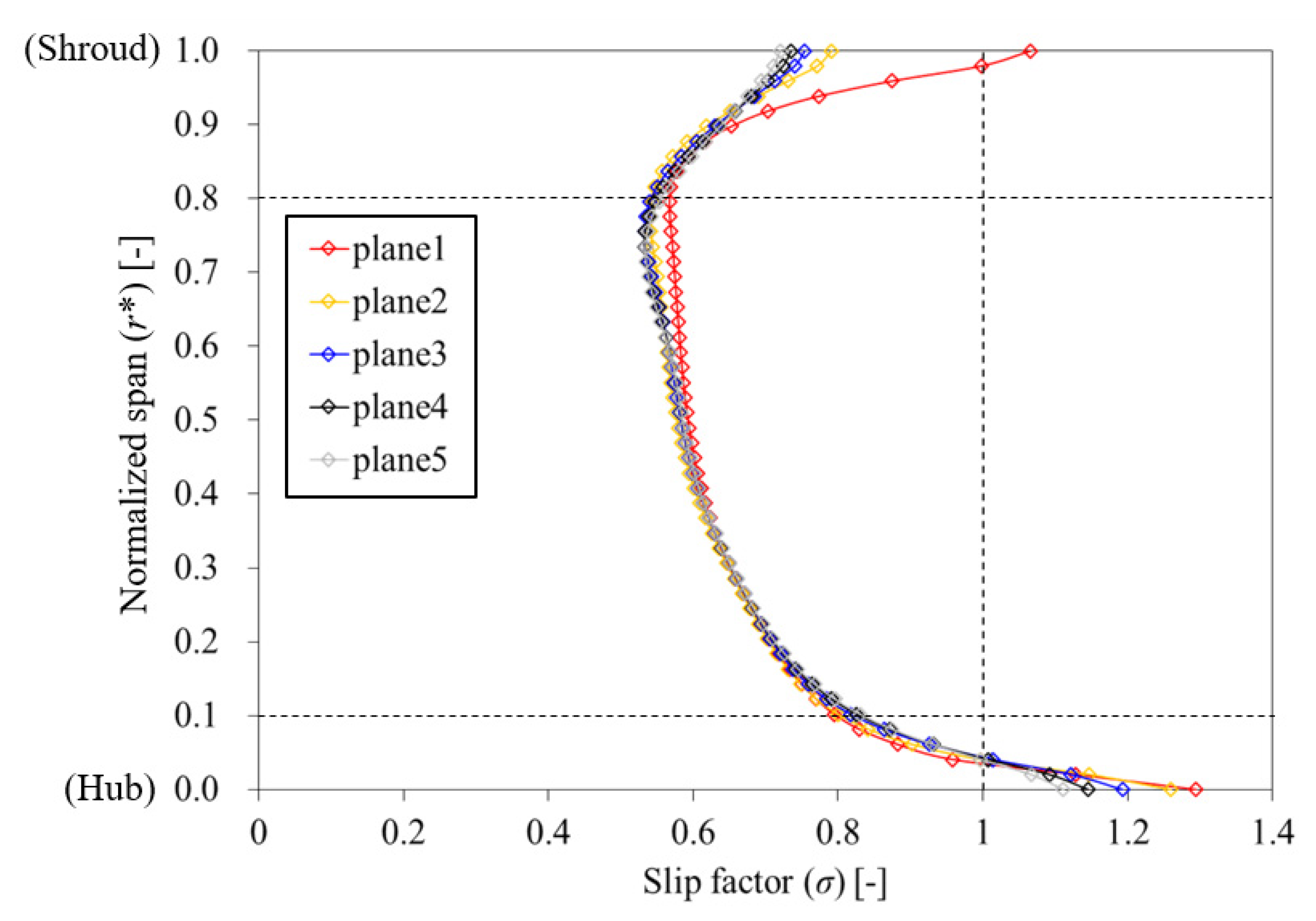

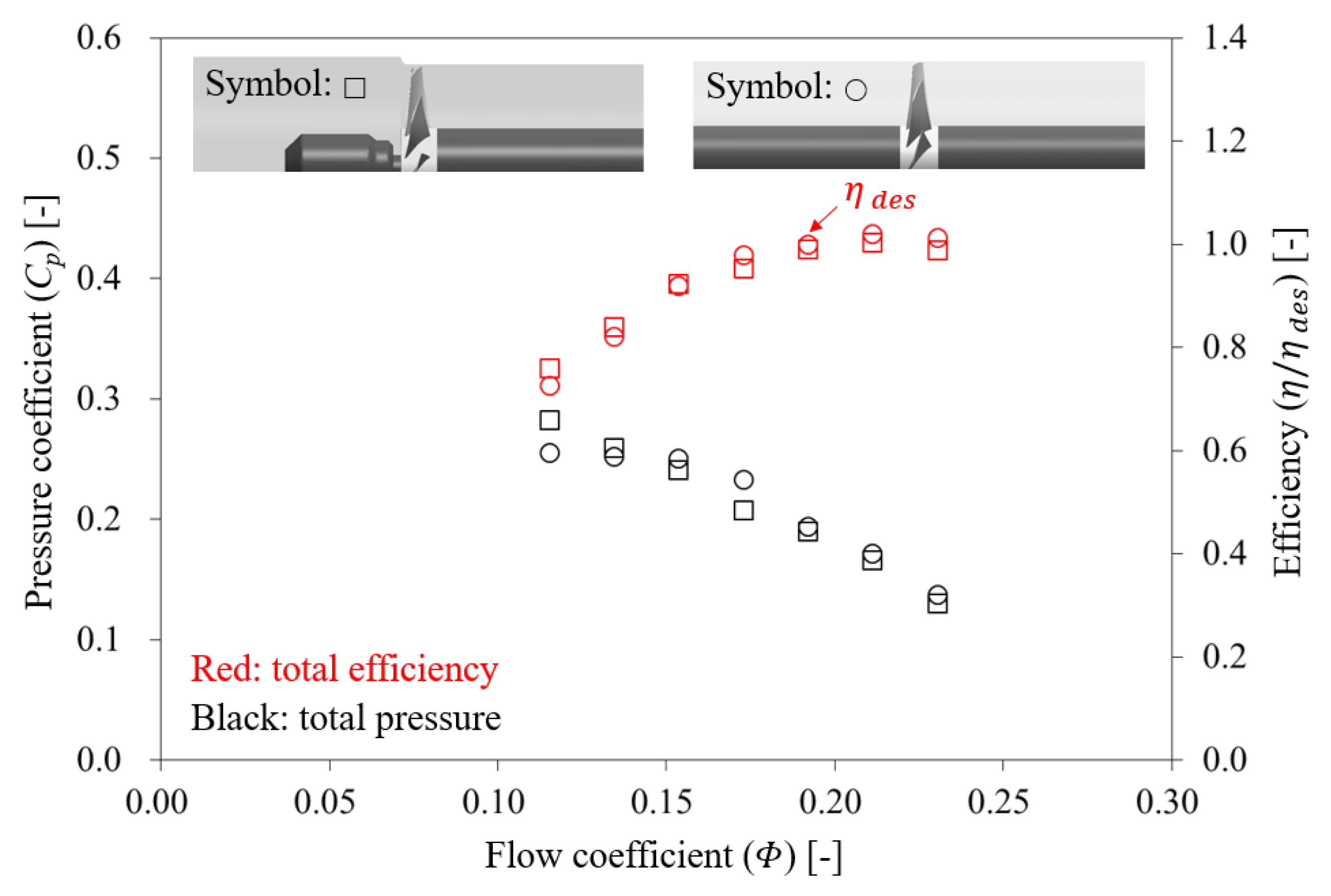
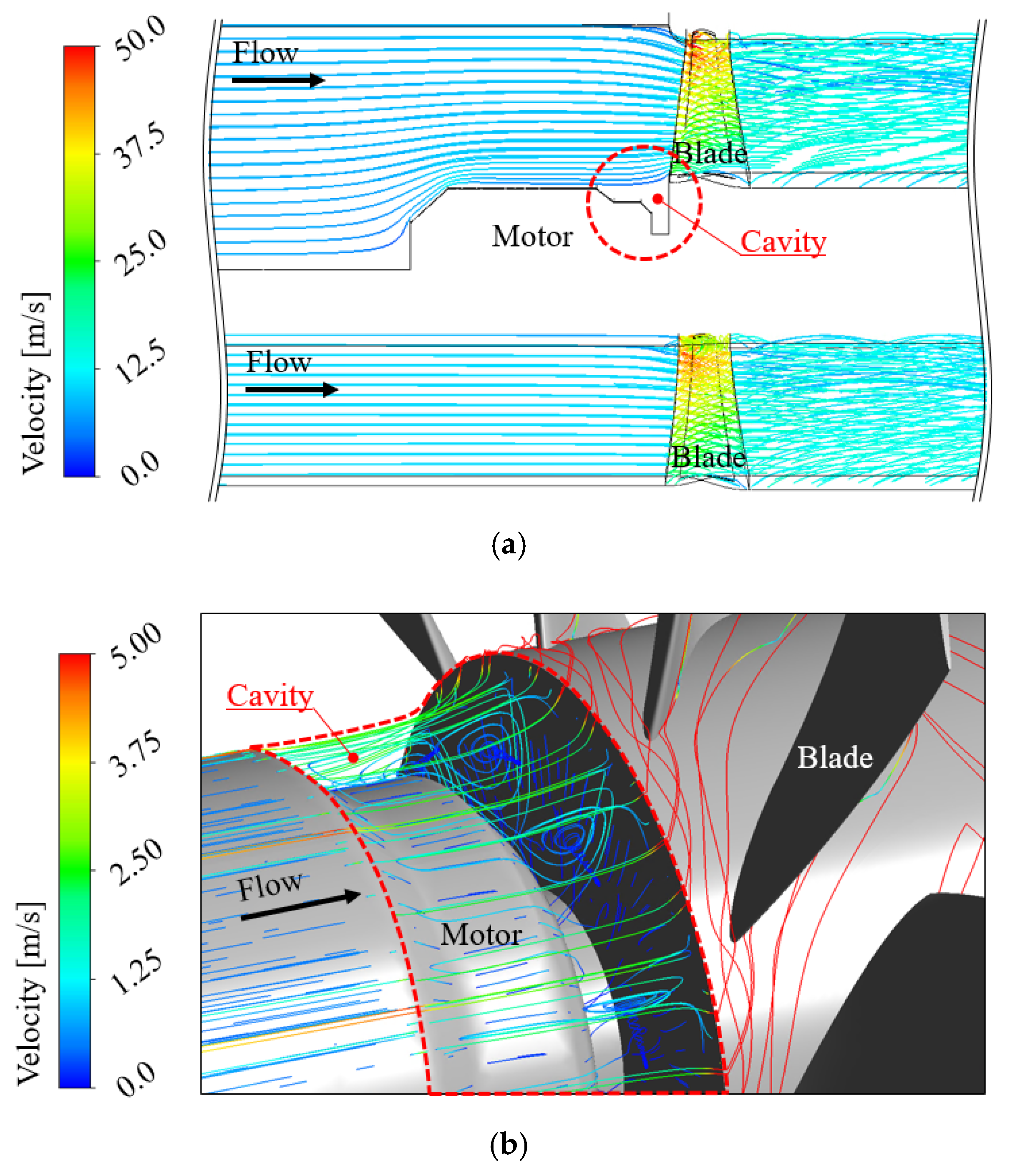

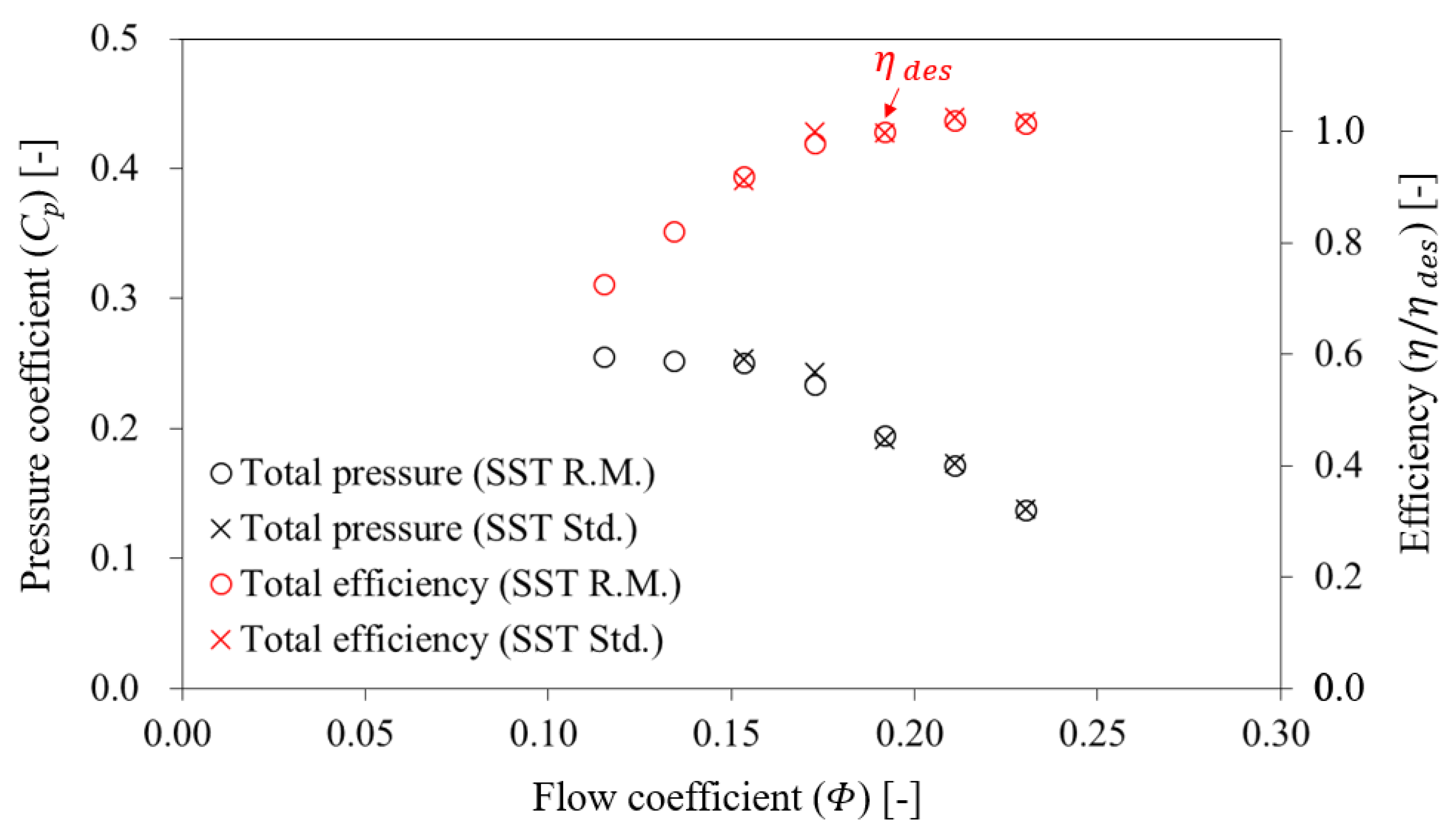
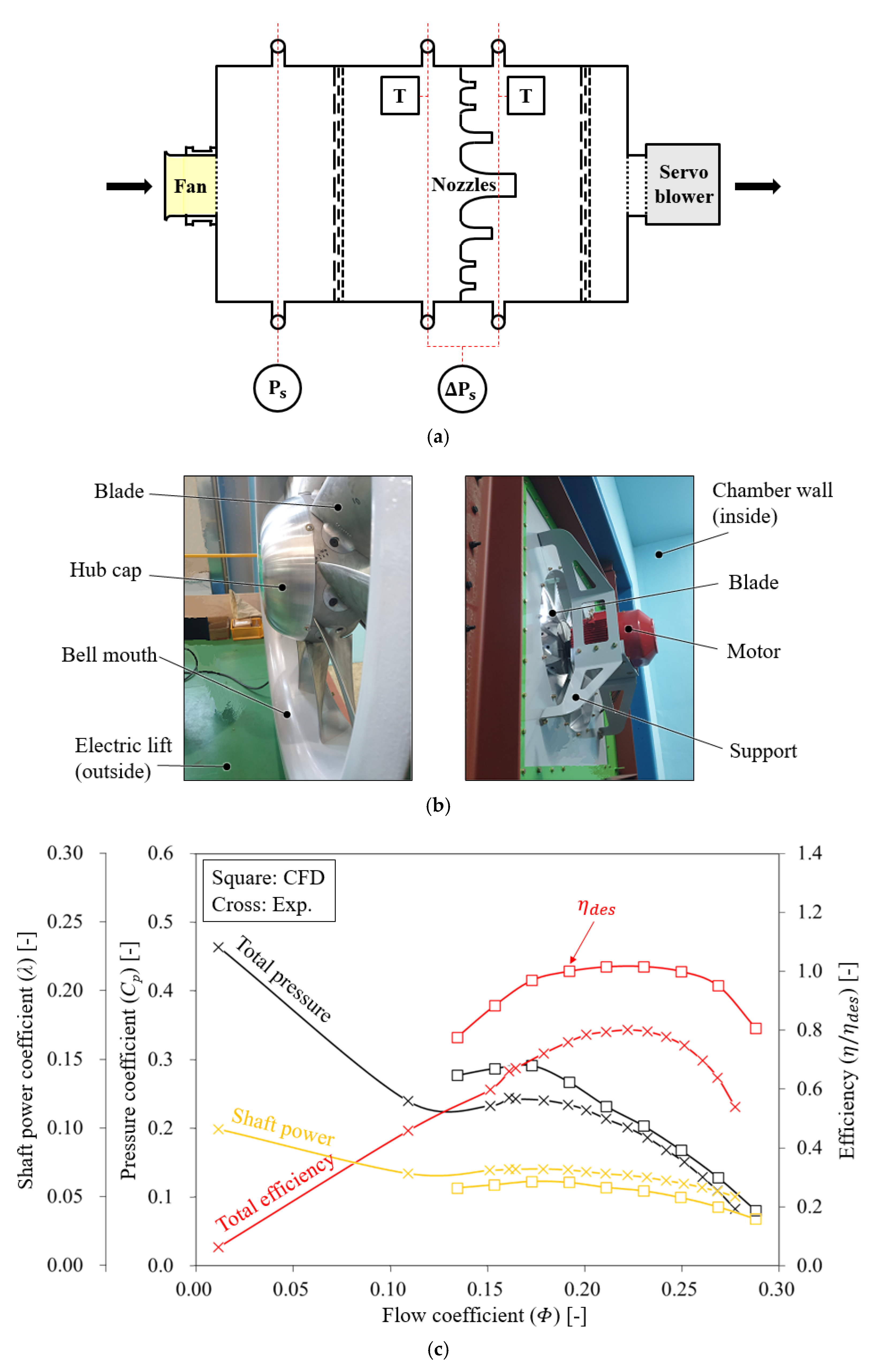
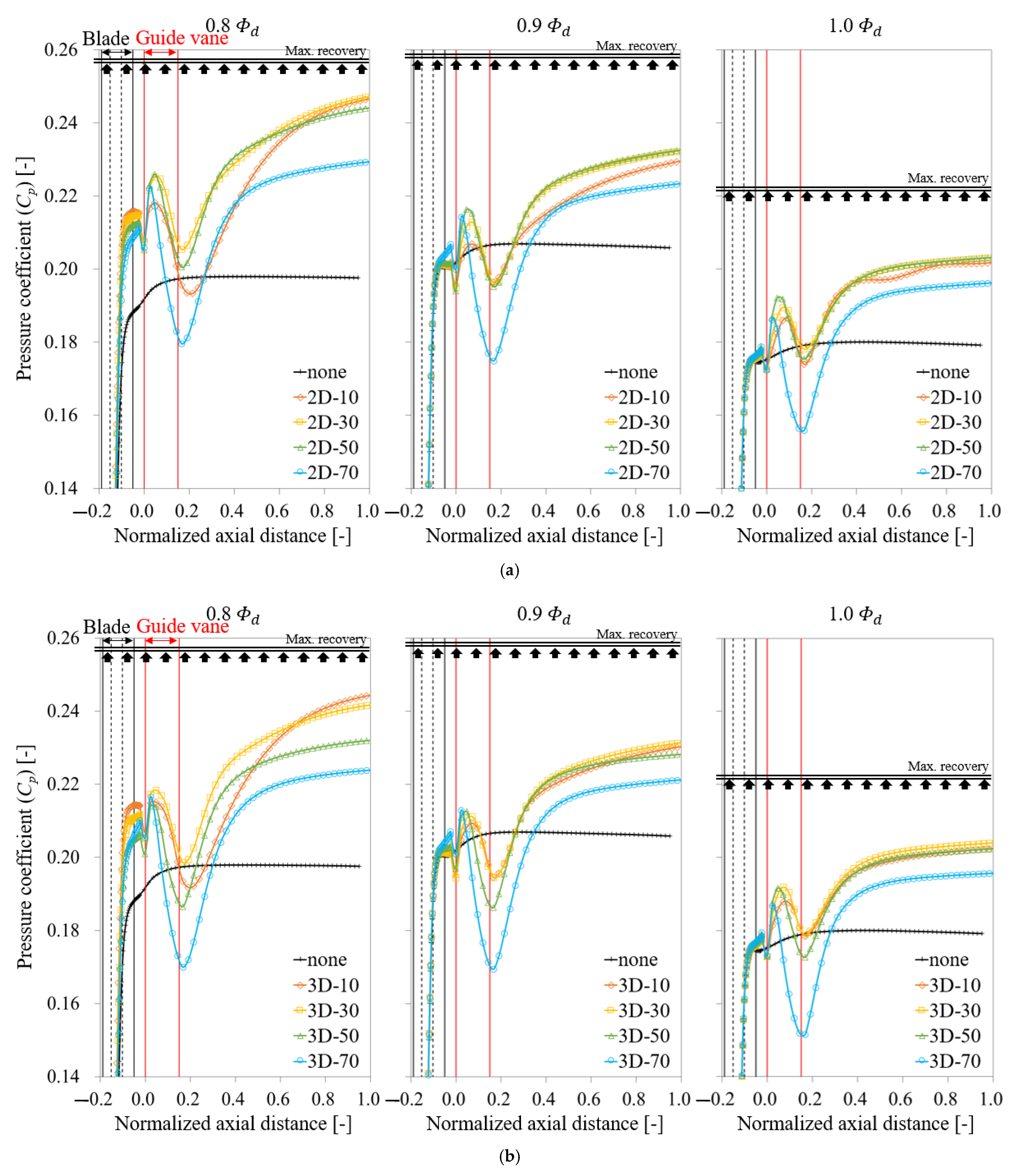
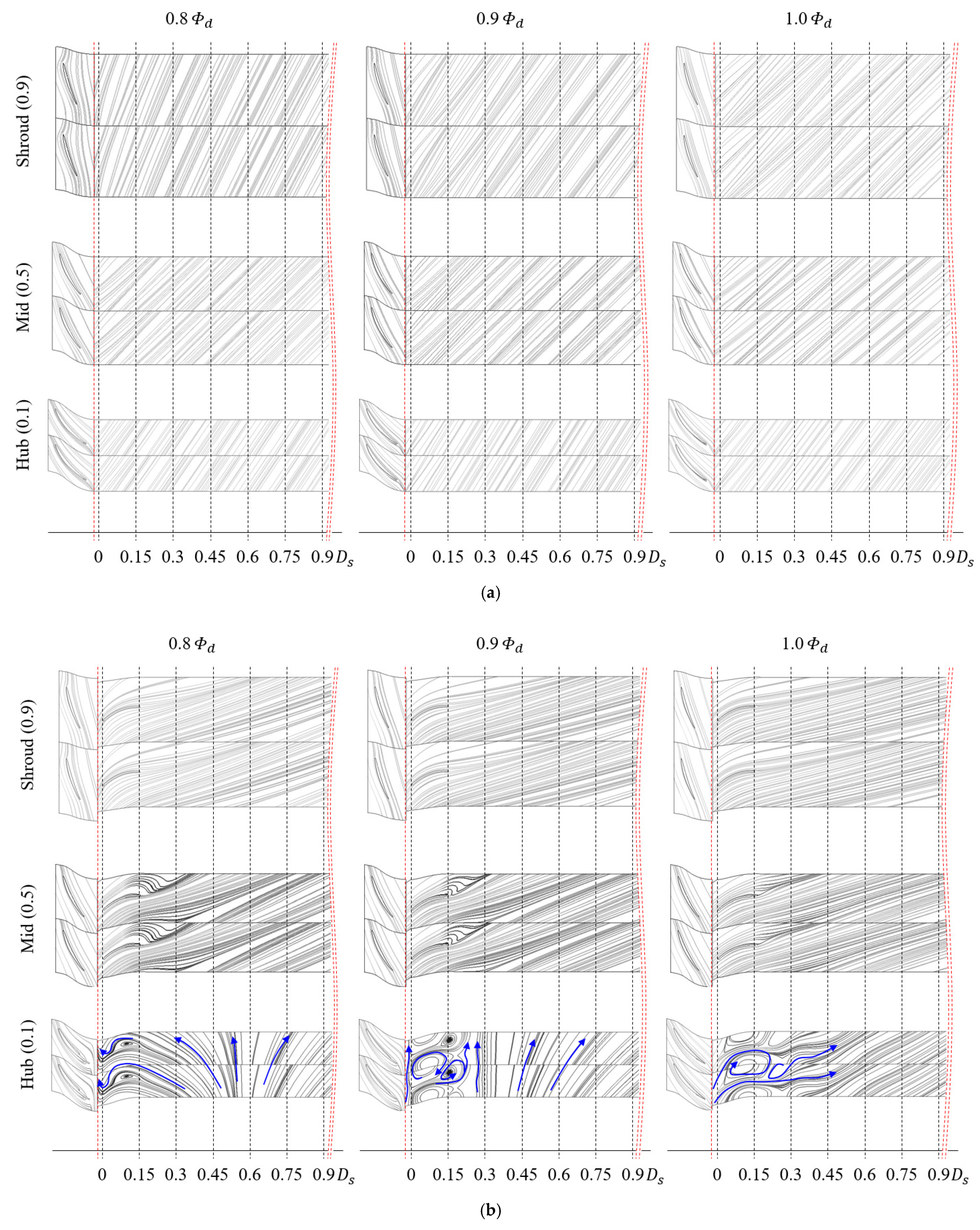
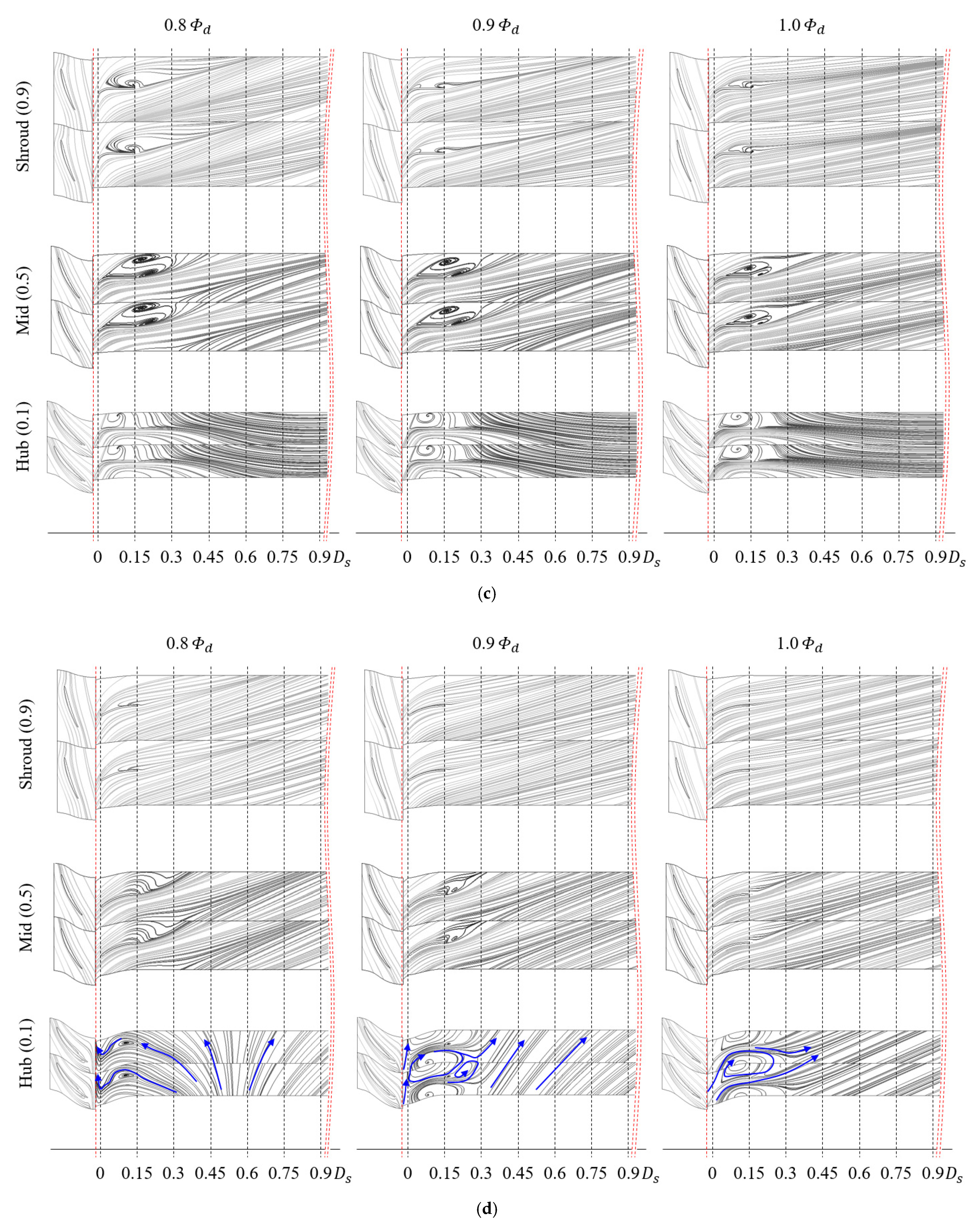
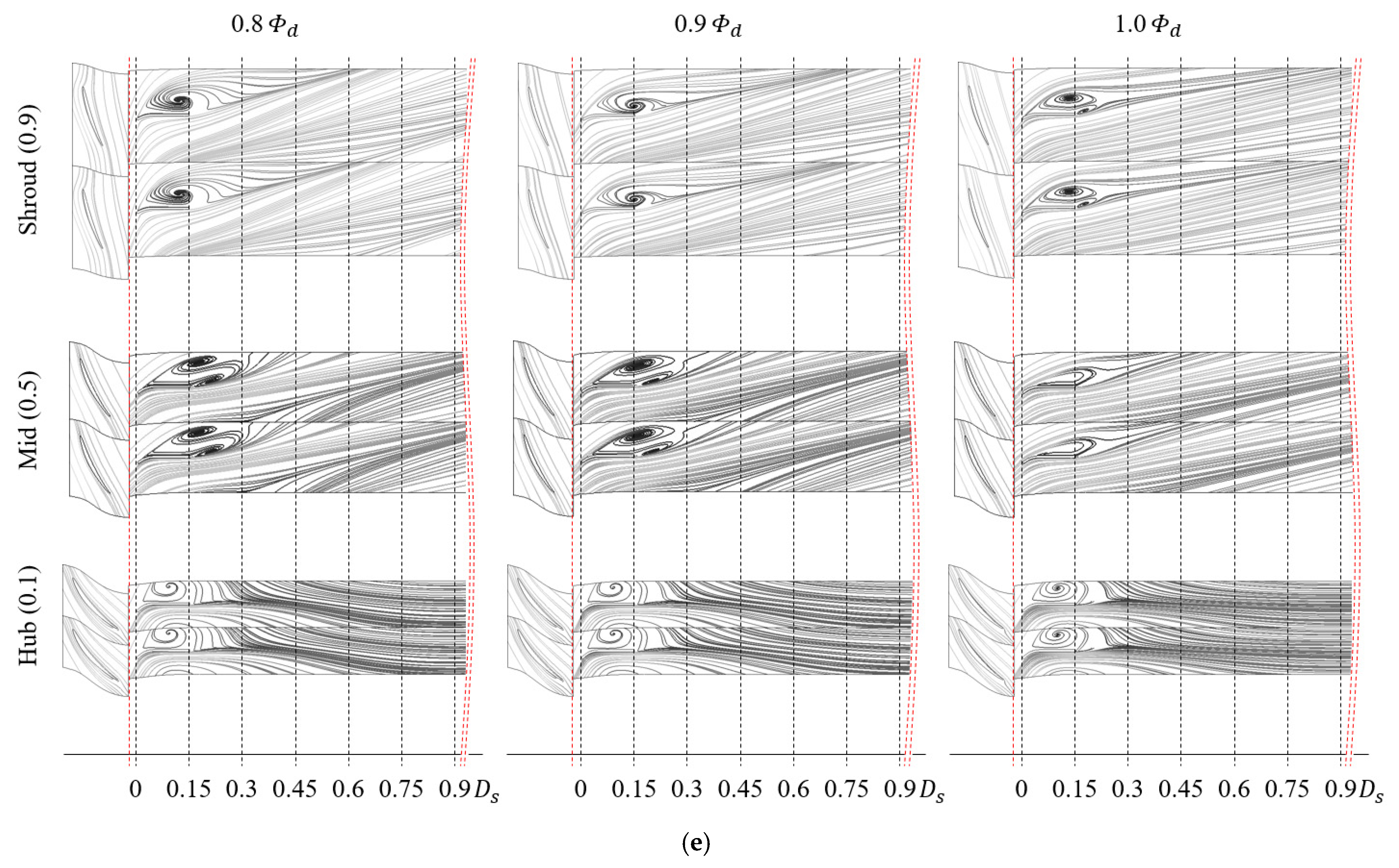
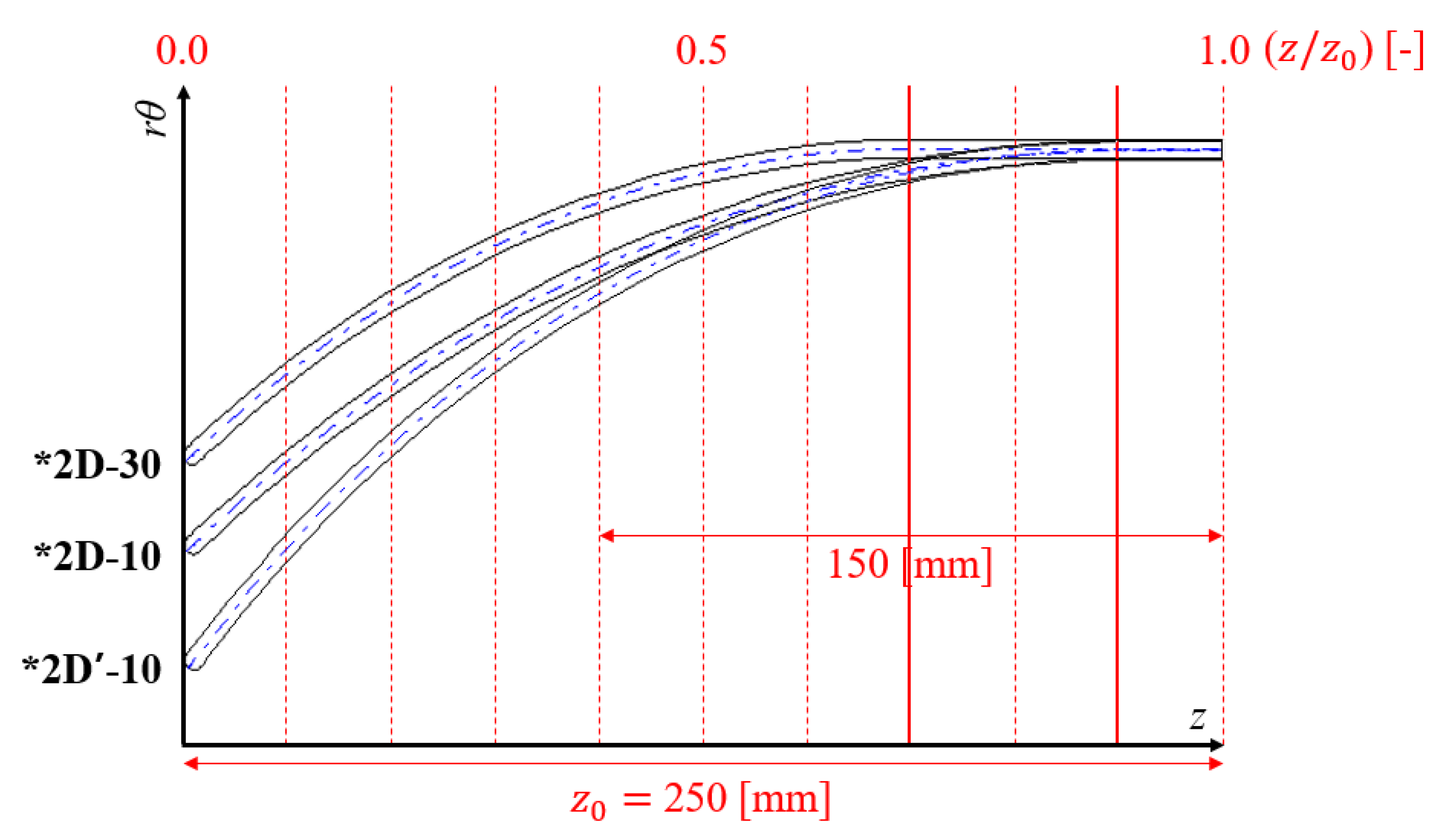

| Specification | Value | Unit |
|---|---|---|
| Specific speed () | 3.9 | (-) |
| Flow coefficient () | 0.19 | (-) |
| Pressure coefficient () | 0.24 | (-) |
| Rotational speed () | 880 | (rpm) |
| Hub ratio () | 0.41 | (-) |
| Parameter | Value | Unit |
|---|---|---|
| Chord length | 192.3 (hub), 178.3 (shroud) | (mm) |
| Meridional length | 138.8 (hub), 50.6 (shroud) | (mm) |
| Max. thickness (airfoil) | 12.9 (hub), 9.3 (shroud) | (mm) |
| Setting angle 1 | 46.2 (hub), 16.4 (shroud) | (degrees) |
| No. of blades () | 10 | (-) |
| Parameter | Normalized Value (Unit) 1 | Actual Value (Unit) |
|---|---|---|
| Meridional length (total) | 0.15 (-) | 150 (mm) |
| Meridional length (linear) | 0.1, 0.3, 0.5, 0.7 (-) 2 | - |
| Axial gap 3 | 0.05 (-) | 50 (mm) |
| Vane thickness | 0.0045 (-) | 4.5 (mm) |
| No. of vanes () | - | 11 (-) |
Publisher’s Note: MDPI stays neutral with regard to jurisdictional claims in published maps and institutional affiliations. |
© 2021 by the authors. Licensee MDPI, Basel, Switzerland. This article is an open access article distributed under the terms and conditions of the Creative Commons Attribution (CC BY) license (https://creativecommons.org/licenses/by/4.0/).
Share and Cite
Kim, Y.-I.; Choi, Y.-U.; Jeong, C.-Y.; Lee, K.-Y.; Choi, Y.-S. Effect of Two- and Three-Dimensionally Designed Guide Vanes with Different Camber Length on Static Pressure Recovery of a Wall-Mounted Axial Fan. Processes 2021, 9, 1595. https://doi.org/10.3390/pr9091595
Kim Y-I, Choi Y-U, Jeong C-Y, Lee K-Y, Choi Y-S. Effect of Two- and Three-Dimensionally Designed Guide Vanes with Different Camber Length on Static Pressure Recovery of a Wall-Mounted Axial Fan. Processes. 2021; 9(9):1595. https://doi.org/10.3390/pr9091595
Chicago/Turabian StyleKim, Yong-In, Yong-Uk Choi, Cherl-Young Jeong, Kyoung-Yong Lee, and Young-Seok Choi. 2021. "Effect of Two- and Three-Dimensionally Designed Guide Vanes with Different Camber Length on Static Pressure Recovery of a Wall-Mounted Axial Fan" Processes 9, no. 9: 1595. https://doi.org/10.3390/pr9091595








